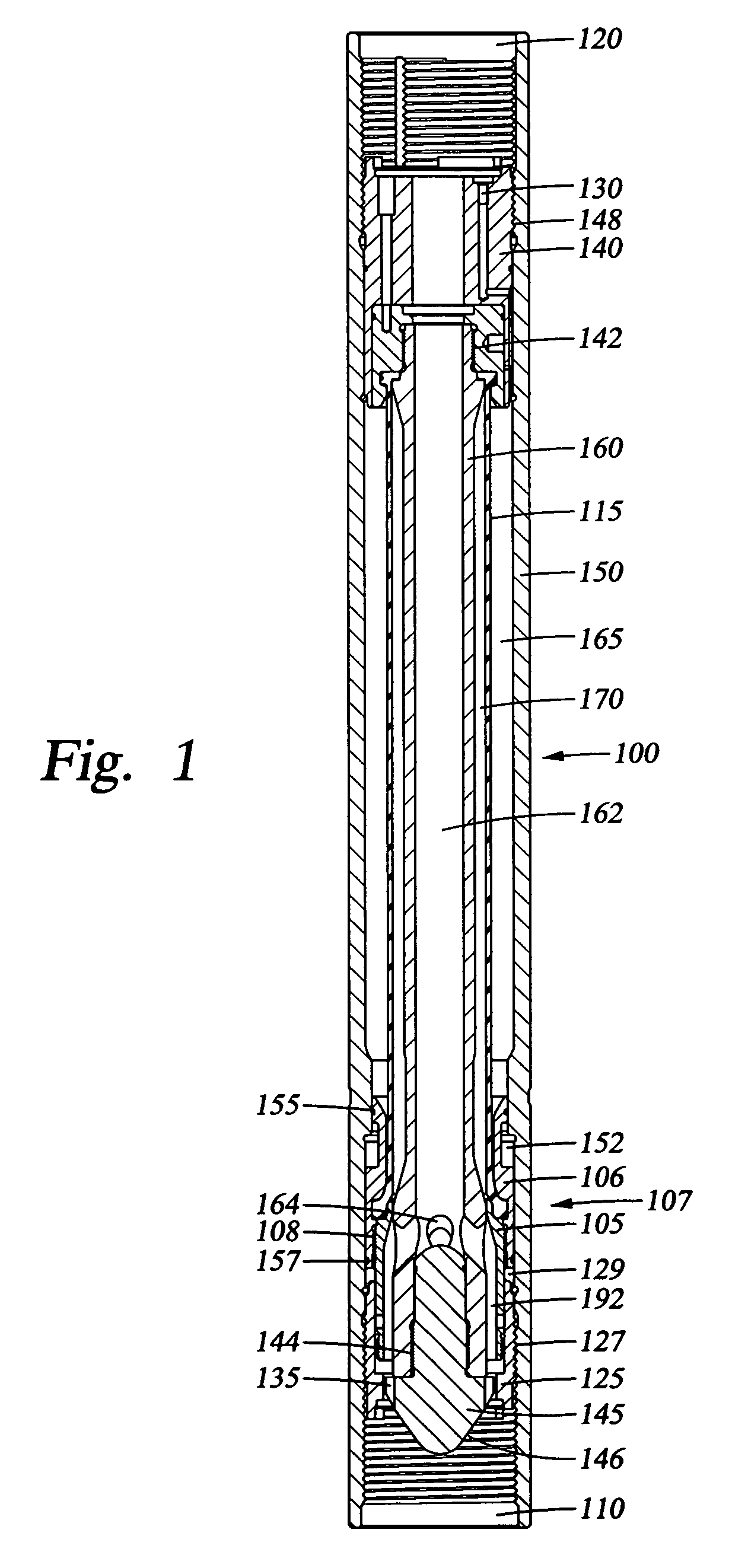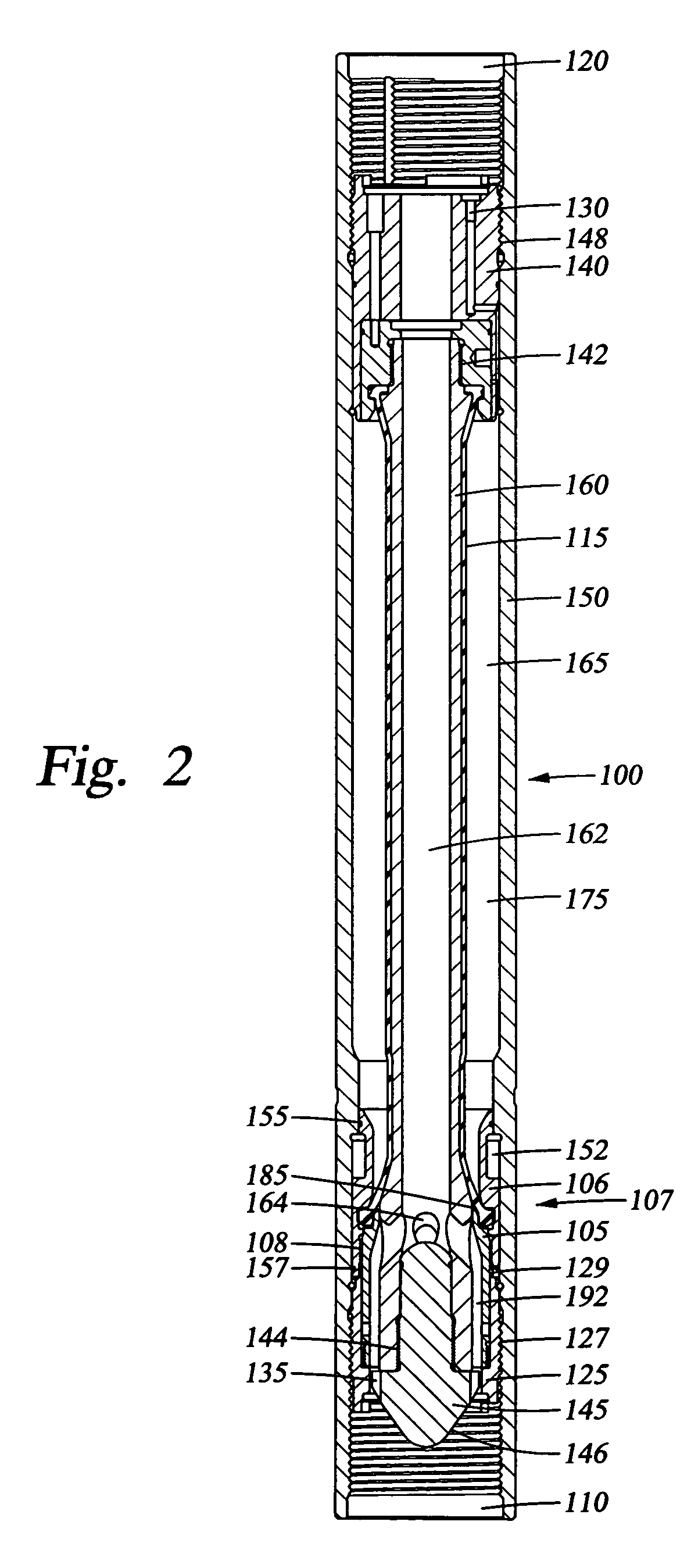Inline bladder-type accumulator for downhole applications
a technology of accumulator and bladder, which is applied in the direction of liquid transfer devices, process and machine control, instruments, etc., can solve the problems of fluid shock wave, fluid shock wave, pressure pulsation, difficulty in removing, etc., and achieve the effect of improving the performance of a fluid hammer
- Summary
- Abstract
- Description
- Claims
- Application Information
AI Technical Summary
Benefits of technology
Problems solved by technology
Method used
Image
Examples
second embodiment
[0042]The anti-extrusion device in accumulator 100 is a pressure actuated two-part piston 107, but the anti-extrusion device of an inline bladder-type accumulator may take different forms. FIG. 4 depicts an inline bladder-type accumulator 200 in the downhole configuration. The accumulator 200 utilizes a pressure actuated ported sliding mandrel 205 as the anti-extrusion device. The inline bladder-type accumulator 200 comprises the sliding mandrel 205 with an internal flow bore 202 and ports 210 extending through the wall thereof, a spring housing 215 forming a spring chamber 260 that encloses springs 220, and a flexible elastomeric bladder 115 retained by a bladder retainer 240, all enclosed within a cylindrical housing 150. The bladder 115 separates a gas compartment 165, located between the outer surface of the bladder 115 and the inner surface of the housing 150, from a fluid compartment 170, located between the inner surface of the bladder 115 and the outer surface of the mandrel...
third embodiment
[0045]In other embodiments, the routing of flow through the accumulator may also vary. FIGS. 1-4 depict “flow-through” accumulators 100, 200 with flow bores 162, 202 that direct fluid flow through the center of the accumulator 100, 200, and that flow is diverted to an externally located bladder 115. FIG. 5, on the other hand, depicts an inline bladder-type accumulator 300, namely a “flow-around” accumulator 300, wherein the fluid 180 flows along an external flow path 302, and that flow is diverted to an internally located bladder 115.
[0046]FIG. 5 depicts the accumulator 300 in the downhole configuration. Accumulator 300 comprises a sliding cylinder 351 with ports 353 extending through a wall thereof, a bladder support mandrel 345 connected via threads 347 to a mandrel support ring 340 comprising flow ports 304 leading into the flow path 302, a cavity 315 disposed between the sliding cylinder 351 and the bladder support mandrel 345 wherein springs 220 reside, and a flexible elastomer...
fourth embodiment
[0049]Referring now to FIG. 6, an inline, flow-through, bladder-type accumulator 400 is depicted that utilizes an anti-extrusion device similar to the accumulator 100 shown in FIGS. 1-3, namely a piston 407 consisting of two sub-components, an upper piston 406 and a lower piston 405. However, in accumulator 400, the piston 407 is bound from further movement at the downstream end by a retainer ring 425. FIG. 6 shows the accumulator 400 in the precharged configuration. The accumulator 400 comprises a cylindrical mandrel 160 with an internal flow bore 162, a flexible elastomeric bladder 115 surrounding the mandrel 160, a piston 407 with a seal 155, a threaded sleeve 430 to which a valve may be connected to inject nitrogen, and a retainer ring 425, all enclosed within a cylindrical housing 150. The bladder 115 resides between two compartments, a gas compartment 165, shown precharged with nitrogen 175, and a fluid compartment 170 that has fluid 180 therein in the position shown in FIG. 6...
PUM
 Login to View More
Login to View More Abstract
Description
Claims
Application Information
 Login to View More
Login to View More - R&D
- Intellectual Property
- Life Sciences
- Materials
- Tech Scout
- Unparalleled Data Quality
- Higher Quality Content
- 60% Fewer Hallucinations
Browse by: Latest US Patents, China's latest patents, Technical Efficacy Thesaurus, Application Domain, Technology Topic, Popular Technical Reports.
© 2025 PatSnap. All rights reserved.Legal|Privacy policy|Modern Slavery Act Transparency Statement|Sitemap|About US| Contact US: help@patsnap.com



